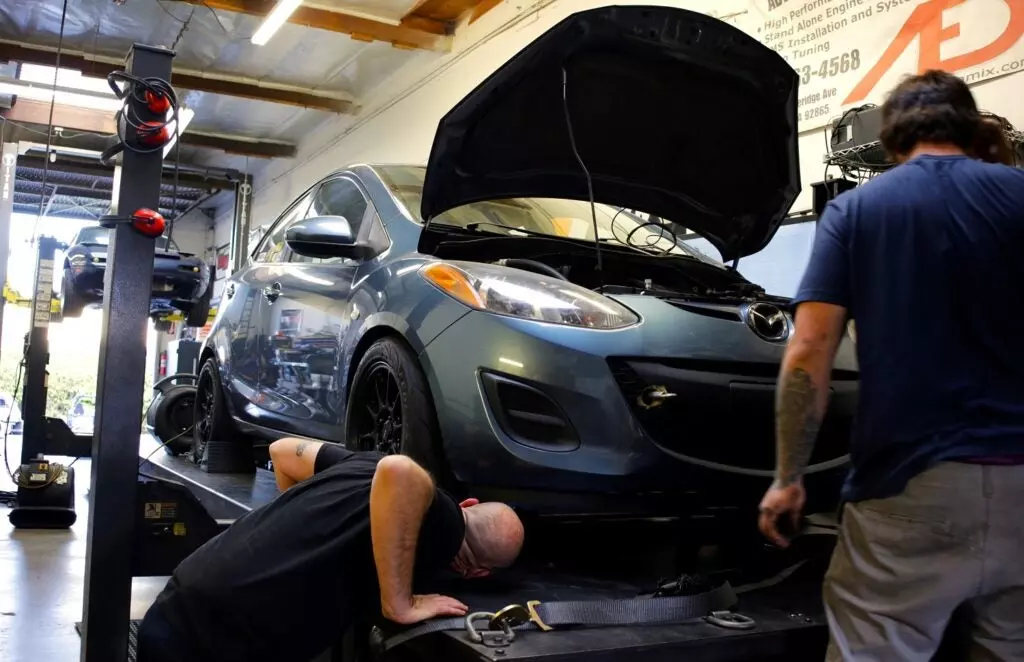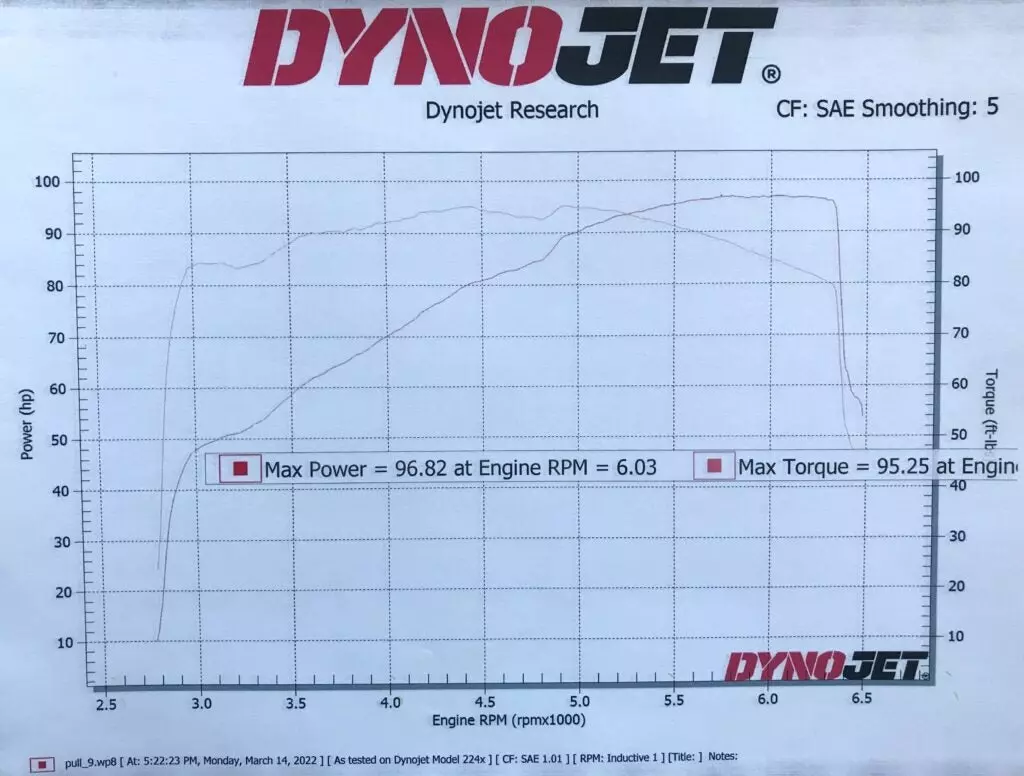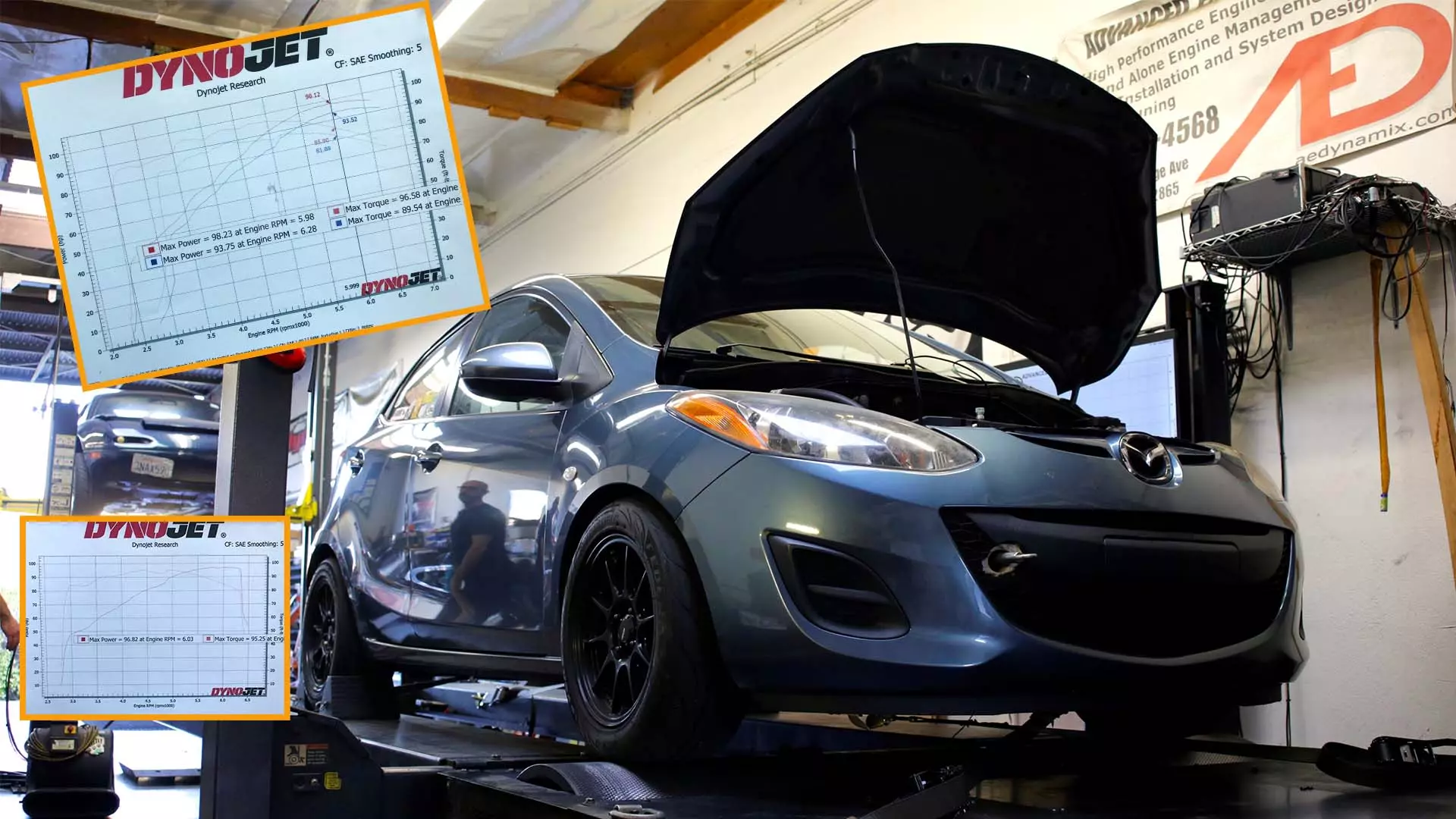I have a ton of fun stuff planned for my Mazda 2, a car that is just too practical and sensible to get rid of. I’ve decided to concentrate on all things track-related this year, so that means I’m swapping back to stiffer coilover suspension, getting back into doing back-breaking DIY alignments in my driveway (I’m not looking forward to this), and trying to find a little bit more horsepower for hustling around my favorite circuits.
The last point is a primary focus, as I’ve worked with 100 crank horsepower since I bought the thing back in 2014. That’s why I recently invested in a couple of small engine modifications to squeeze a tad more enthusiasm out of the 2’s small-power, large-moxie 1.5-liter four-cylinder.
I wanted to see how these mods reflected on the dyno, so I booked a session with Advanced Engine Dynamix in Corona, California, to find out. I spent my own hard-earned scratch on all modifications and dyno time.
I should note that I’ve had a short ram intake and axle-back exhaust installed since the odometer read 10,000 miles (It’s now at 116,000). Last year I threw on a European Mazda 1.6-liter MZR throttle body that’s a bit wider than what my US market 1.5-liter MZR received. These changes improved sound and throttle response, and sure enough seemed to bump up factory figures pretty significantly.
The Spec Miata Trick

Word among some friends of mine who’ve raced in the Sports Car Club of America’s (SCCA) Spec Miata class is that a modification as simple as gapping platinum spark plugs to .055 can net as much as 5 horsepower and add a little bit of torque. I assume that’s wheel horsepower, as crank isn’t readily measurable by really anyone. This is pretty freaking impressive. The NGK G-Power Platinum spark plugs that are popular to use for this mod retail for just $18 for a set of four shipped to my residence. Eighteen whole American dollars. If true, this is one of the best bang-for-your-buck modifications ever.
Factory spec for the Mazda 2 is four NGK iridium plugs, which can range in price from $30 to nearly $90, depending on where you buy them. To give iridium the best chance possible, I bought the $18 platinums and gapped them appropriately and bought a set of fresh Bosch Double-Iridium plugs at factory-spec gap for $35.
An Angrier ECU

In the SCCA B-Spec racing class, one of the allowable mods to make the Mazda 2 more equal among its Honda Fit, Ford Fiesta, Fiat 500, Chevy Sonic, and Mini Cooper rivals is an engine control unit (ECU) tune. I sourced an ECU with a B-Spec-legal tune on it for $325.
The primary function of the ECU is to handle the delicate mix of spark, air, and fuel to move the car forward. The biggest benefit to this ECU tune is that it raises the redline from a paltry 6,200 rpm to 7,500 rpm. This greatly improves gearing, especially on smaller, tighter tracks. You don’t have to briefly shift to fourth gear before having to downshift again for a corner — it can hang high in the rev range for a little while longer. This pain is felt by many folks who track small four-cylinders that aren’t Hondas. Going up to 7,500 rpm might sound a little scary for a factory engine, but some folks who have tuned these engines even further have seen 8,200 rpm without issue. Plus, as I’d come to learn after the dyno session, the power band tops nearly at the same rpm as the factory ECU, so 7,500 is a nice cushion for holding gears before corners, rather than a requirement to reach peak power.
Otherwise, it widens the power band, makes the engine rev up faster, and gives it a more manageable redline. Instead of a fuel cut that’s really awkward to hit at 6,200 RPM, it smoothly bounces at 7,500 rpm.
It must be said that this modification is intended for off-road use only. States with strict emission standards will frown on it, and it also disables the immobilizer, so a B-Spec tuned 2 is as easy to steal as an old CRX. However, the good thing about Mazda 2 ECUs is they’re incredibly easy to swap under the hood. The ECU housing is a part of the airbox, so unclipping the two massive connectors and undoing four five-point Torx bolts is all it takes. Then the little green circuit board slides right out. This is very handy for swapping the ECU at the track and swapping back to stock before rejoining the public highway.
Mixing Up a Big Bowl of Proof Pudding

So, how would these two modifications reflect on the rollers? When I showed up to Advanced Engine Dynamix, Toby the owner and his employee John were incredibly friendly and just as stoked to find out what the 2 would make as I was. They happily dyno anything that requires a two-wheel dyno and have been helping enthusiasts reach their power goals for more than eight years. They’re fellow car nerds who just want to do cool stuff with cars, and I had a great time hanging out with them. They strapped the 2 down, started the fan, and we got to work.
Up first, Toby did a series of pulls with the B-Spec ECU plugged in and the gapped platinum spark plugs. I was hoping to see 100-105 wheel horsepower, but unfortunately, it didn’t get that high. In fact, the best pull was the first, the following couple revealed that the intake heat soaked a bit, even with the hood up and fan blowing, and it lost a few horses by the final pull.
The results were 98 wheel horsepower and 96 pound-feet of torque! Again, I was hoping for more, but I’m still content. That’s a whole 13 more ponies than 2 enthusiasts say they make bone-stock, which is nothing to sneeze at in a car that weighs 2,300 pounds and is easy to drop down to around 2,100 pounds. We all chuckled at these cute little figures but were also quite impressed with how the dyno graph looked.
This is only slightly more horsepower and torque than with the factory ECU plugged in, but the healthier torque and power curves that jump up sooner are immensely appreciated.
Changing Things Up and Reaping Rewards

The following groups of pulls were different mixes of parts. The first group was gapped platinum plugs and the B-Spec ECU, the second was iridium plugs and the B-Spec ECU, the third was iridium plugs and stock ECU, and the final group was gapped platinum plugs mixed with the factory ECU.
Of all combinations, the first group appeared to be the best by a hair. You see, the spark plugs didn’t really make much of a difference. On my setup, the gapped plugs made maybe 0.20 more horsepower and 0.20 pound-feet of torque with the B-Spec ECU, which even in this lightweight hatchback absolutely isn’t noticeable.
I’m not discounting the Spec Miata spark plug trick, and I swear my butt dyno revealed a slightly healthier top-end of the tach with ’em. But this trick could possibly be chalked up to this: It works for Spec Miatas, not for Mazda 2s with vastly different power figures, OEM tuning, etc. I’m out a little bit of cash in this end of the experiment, but eh, there are worse ways to throw away money living the life of a track rat who’s, for some reason, still infatuated with this dumb little hatch.
The B-Spec ECU, on the other hand, was a solid investment. Torque indeed jumps up higher and sooner, compared to the factory ECU. It stays stronger longer, and the power curve is consistently higher than the factory unit, as well. It’s not just about peak numbers, the figures are always consistently higher. Plus, the added benefit of the raised rev limit.
Lessons Learned

After all of the pull groups, Toby sat down with me and helped me further analyze all of this data. His and John’s main suggestion was to do everything I can to get consistent cool air to the intake. Although it’s probably fed plenty of cool air rolling down the highway, twisty track circuits with braking zones and corners are a different story.
John even aimed the fan directly at the intake during a couple of pulls during one of the groups. Sure enough, the figures stayed more consistent than otherwise. This is definitely something I’m looking forward to: I’m going to engineer a way to route cool air to the air filter, while also blocking off under-hood heat. I’ve already got a solid idea in my head of how to do so, too.
Thoroughly Stoked
My session at Advanced Engine Dynamix has left me incredibly excited to get to work doing some DIY projects, as well as setting up the 2 for better track-focused duty. With a bit more power, a healthier torque curve, and higher redline, I’m confident that I might be able to beat my personal best at Streets of Willow-Clockwise by a couple of seconds. I’m at 1:35.75, we’ll see how much lower I can go.
What to read next:
- The Car Autance series Car Confessions and Hard Lessons continues on with Alanis King explaining why you should never sell your car with your license plates on it.
- This sure seems like the 2023 Acura Integra interior we haven’t seen yet.
- Check out our internet talk show, Hooptie Happy Hour, now available in podcast form!
- EVs and hybrids are given efficiency ratings in MPGe, but what does that actually mean? Kevin Williams explains how it works.
- Chris Rosales explains how he got his tuned Volkswagen GTI to pass smog under California’s new rules and restrictions.
- This electrified Airstream RV concept could be the future of camping and road-tripping.
- Lego car engineering is a great candidate to be your next at-home hobby.









